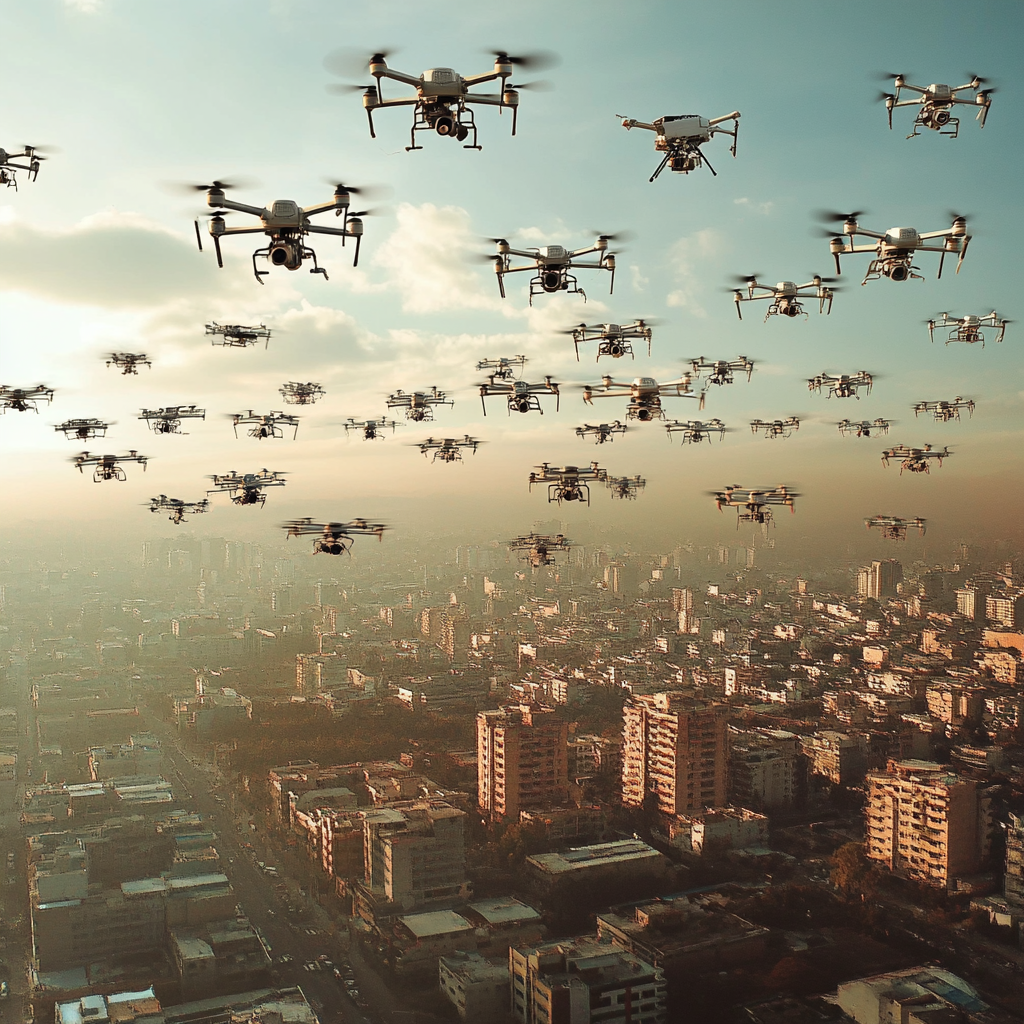Introduction
In the world of the develpment of unmanned aerial vehicles (UAVs) or drones, security is paramount. As these flying marvels become increasingly integrated into various sectors, from military operations to civilian applications, the need for robust security measures has never been more critical. At Decent Cybersecurity, we’re at the forefront of this challenge, developing cutting-edge solutions like our DroneCrypt IFF system that incorporate post-quantum algorithms to ensure the highest level of security for drone operations.
But why the focus on post-quantum algorithms? The answer lies in the looming threat of quantum computers. While still in development, quantum computers have the potential to break many of the cryptographic systems we rely on today. This article delves into the world of post-quantum algorithms for drone security, exploring their importance, implementation, and the role they play in securing the skies of tomorrow.
The Quantum Threat to Drone Security
Understanding the Quantum Challenge
Quantum computers leverage the principles of quantum mechanics to perform certain computations exponentially faster than classical computers. This capability poses a significant threat to many current cryptographic systems, particularly those based on:
- Integer factorization (e.g., RSA)
- Discrete logarithms (e.g., Diffie-Hellman key exchange)
- Elliptic curve cryptography
These systems form the backbone of much of our current digital security infrastructure, including that used in drone communications and authentication.
The Urgency for Drone Security
Drones are particularly vulnerable to quantum threats due to several factors:
- Long-term data sensitivity: Information transmitted by drones, especially in military or sensitive civilian applications, may remain confidential for extended periods.
- Resource constraints: Drones often have limited computational resources, making it challenging to implement complex security measures.
- Real-time operations: Drone operations require secure, real-time communications, leaving little room for latency in cryptographic processes.
Given these challenges, the development and implementation of post-quantum algorithms for drone security is not just a future consideration—it’s an immediate necessity.
Post-Quantum Algorithms: The Next Frontier in Drone Security
At Decent Cybersecurity, our DroneCrypt IFF system exemplifies the application of post-quantum algorithms in drone security. Let’s explore some of the key algorithms and their applications:
1. Lattice-Based Cryptography
Lattice-based cryptography forms the foundation of many post-quantum algorithms due to its versatility and strong security properties.
CRYSTALS-Kyber
Our DroneCrypt IFF system utilizes CRYSTALS-Kyber, a lattice-based key encapsulation mechanism (KEM). Kyber offers several advantages for drone security:
- Efficiency: Kyber provides fast key generation, encapsulation, and decapsulation, crucial for real-time drone operations.
- Compact keys and ciphertexts: Important for bandwidth-constrained drone communications.
- Provable security: Based on the hardness of the Module Learning With Errors (MLWE) problem.
In DroneCrypt IFF, Kyber provides a 256-bit post-quantum security level, with key generation, encapsulation, and decapsulation times of less than 1ms each.
CRYSTALS-Dilithium
For digital signatures, DroneCrypt IFF employs CRYSTALS-Dilithium, another lattice-based algorithm. Dilithium offers:
- Fast signature generation and verification: Essential for real-time drone authentication.
- Relatively small signature sizes: Crucial for efficient communication in drone swarms.
- Strong security guarantees: Based on the hardness of lattice problems.
Our implementation achieves a 128-bit post-quantum security level, with signature generation time under 2ms and verification time less than 1ms.
2. Hash-Based Signatures
While not currently implemented in DroneCrypt IFF, hash-based signatures represent another promising avenue for post-quantum drone security:
SPHINCS+
SPHINCS+ is a stateless hash-based signature scheme that offers:
- Long-term security: Based solely on the security of its underlying hash function.
- No requirement for secure state management: Advantageous for drones with limited secure storage.
Research by Huelsing et al. (2022) demonstrates the potential of SPHINCS+ for secure drone communications in resource-constrained environments [1].
3. Isogeny-Based Cryptography
Isogeny-based systems, while still maturing, offer some unique advantages for drone security:
SIKE (Supersingular Isogeny Key Encapsulation)
SIKE provides:
- Extremely small key sizes: Beneficial for drones with limited storage and bandwidth.
- Perfect forward secrecy: Essential for protecting long-term sensitivity of drone communications.
However, recent advances in cryptanalysis have raised concerns about SIKE’s long-term security, highlighting the need for ongoing research and development in post-quantum algorithms [2].
Implementing Post-Quantum Algorithms in Drone Systems
Integrating post-quantum algorithms into drone security systems presents several challenges:
1. Resource Constraints
Drones often have limited computational power, memory, and energy resources. Our approach in DroneCrypt IFF includes:
- Optimized implementations: Tailoring algorithms for efficient execution on drone hardware.
- Hybrid schemes: Combining post-quantum algorithms with traditional cryptography for a balance of security and efficiency.
2. Bandwidth Limitations
Drone communications often operate under strict bandwidth constraints. Solutions include:
- Compressed cryptographic parameters: Reducing the size of keys and signatures without compromising security.
- Efficient protocols: Minimizing the number of cryptographic operations required for secure communication.
3. Real-Time Performance Requirements
Many drone applications require near-instantaneous secure communication. Our DroneCrypt IFF system achieves:
- Low-latency operations: With processing times under 10ms per transaction.
- Efficient key management: Rapid key generation and exchange to support dynamic drone networks.
4. Interoperability
Drones must often interact with various systems and networks. Key considerations include:
- Standardization: Adhering to emerging standards for post-quantum cryptography, such as those being developed by NIST.
- Backward compatibility: Ensuring new systems can interact with legacy infrastructure.
The Role of Post-Quantum Algorithms in Comprehensive Drone Security
While post-quantum algorithms are crucial, they form part of a larger security ecosystem for drones. At Decent Cybersecurity, we integrate these algorithms with other advanced technologies:
1. Blockchain Integration
Our DroneCrypt IFF system combines post-quantum algorithms with blockchain technology, providing:
- Decentralized trust: Eliminating single points of failure in drone authentication.
- Immutable audit trails: Essential for accountability in drone operations.
- Scalability: Supporting large-scale drone deployments with up to 20,000 transactions per second.
2. AI-Enhanced Security
Artificial Intelligence complements post-quantum cryptography by:
- Anomaly detection: Identifying unusual patterns in drone behavior or communication.
- Adaptive security: Dynamically adjusting security parameters based on threat levels.
3. Secure Hardware Integration
Implementing post-quantum algorithms in conjunction with secure hardware elements provides:
- Protected key storage: Safeguarding cryptographic keys from physical attacks.
- Trusted execution environments: Ensuring the integrity of cryptographic operations.
Future Directions and Ongoing Research
The field of post-quantum cryptography for drone security is rapidly evolving. Key areas of ongoing research include:
- Lightweight post-quantum algorithms: Developing even more efficient algorithms tailored for resource-constrained drone environments.
- Quantum-resistant protocols: Designing complete communication protocols that are inherently resistant to quantum attacks.
- Post-quantum secure multiparty computation: Enabling secure collaborative operations among multiple drones without revealing sensitive information.
- Quantum-safe drone swarm coordination: Developing algorithms for secure, decentralized decision-making in drone swarms.
At Decent Cybersecurity, we’re actively contributing to these research areas, ensuring that our solutions like DroneCrypt IFF remain at the cutting edge of drone security.
Conclusion: Securing the Quantum Future of Drone Operations
As we stand on the brink of the quantum computing era, the importance of post-quantum algorithms in drone security cannot be overstated. These advanced cryptographic techniques are not just a futuristic concept but a present necessity, safeguarding drone operations against both current and future threats.
Our DroneCrypt IFF system, with its integration of CRYSTALS-Kyber and Dilithium, exemplifies the practical application of post-quantum algorithms in real-world drone security solutions. By combining these algorithms with other advanced technologies like blockchain and AI, we’re creating comprehensive security ecosystems that ensure the integrity, confidentiality, and availability of drone operations.
As the drone industry continues to evolve and expand, post-quantum security will play an increasingly critical role. At Decent Cybersecurity, we’re committed to staying at the forefront of this field, continuously innovating to provide the most advanced and secure solutions for the drone operations of today and tomorrow.
The quantum future is coming, and with post-quantum algorithms, we’re ensuring that drone security is ready for it. Together, we’re not just securing drones; we’re securing the future of aviation and beyond.
References
[1] Huelsing, A., Rijneveld, J., Schwabe, P., & Buchmann, J. (2022). SPHINCS+: Submission to the NIST post-quantum project.
[2] Castryck, W., & Decru, T. (2022). An efficient key recovery attack on SIDH (preliminary version). Cryptology ePrint Archive, Report 2022/975.
[3] Alagic, G., Alperin-Sheriff, J., Apon, D., Cooper, D., Dang, Q., Kelsey, J., … & Stebila, D. (2023). Status Report on the Third Round of the NIST Post-Quantum Cryptography Standardization Process. National Institute of Standards and Technology.
[4] Nejatollahi, H., Dutt, N., Ray, S., Regazzoni, F., Banerjee, I., & Cammarota, R. (2022). Post-quantum lattice-based cryptography implementations: A survey. ACM Computing Surveys, 54(6), 1-41.
[5] Developing a Framework to Improve Critical Infrastructure Cybersecurity. National Institute of Standards and Technology. (2023).







